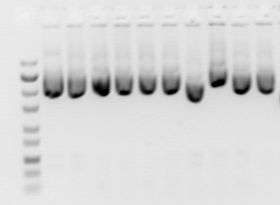Plasmid preparation
A plasmid preparation is a method of DNA extraction and purification for plasmid DNA. Many methods have been developed to purify plasmid DNA from bacteria. These methods invariably involve three steps:[1]
- Growth of the bacterial culture
- Harvesting and lysis of the bacteria
- Purification of plasmid DNA

Growth of the bacterial culture
Plasmids are almost always purified from liquid bacteria cultures, usually E. coli, which have been transformed and isolated. Virtually all plasmid vectors in common use encode one or more antibiotic resistance genes as a selectable marker, for example a gene encoding ampicillin or kanamycin resistance, which allows bacteria that have been successfully transformed to multiply uninhibited. Bacteria that have not taken up the plasmid vector are assumed to lack the resistance gene, and thus only colonies representing successful transformations are expected to grow. Bacteria are grown under favourable conditions.
Harvesting and lysis of the bacteria
When bacteria are lysed under alkaline conditions (pH 12.0–12.5) both chromosomal DNA and protein are denatured; the plasmid DNA however, remains stable. Some scientists reduce the concentration of NaOH used to 0.1M in order to reduce the occurrence of ssDNA. After the addition of acetate-containing neutralization buffer the large and less supercoiled chromosomal DNA and proteins precipitate, but the small bacterial DNA plasmids stay in solution.
Preparations by size
Kits are available from varying manufacturers to purify plasmid DNA, which are named by size of bacterial culture and corresponding plasmid yield. In increasing order, these are the miniprep, midiprep, maxiprep, megaprep, and gigaprep. The plasmid DNA yield will vary depending on the plasmid copy number, type and size, the bacterial strain, the growth conditions, and the kit.
Minipreparation
Minipreparation of plasmid DNA is a rapid, small-scale isolation of plasmid DNA from bacteria. It is based on the alkaline lysis method. The extracted plasmid DNA resulting from performing a miniprep is itself often called a "miniprep". Minipreps are used in the process of molecular cloning to analyze bacterial clones. A typical plasmid DNA yield of a miniprep is 5 to 50 µg depending on the cell strain. Miniprep of a large number of plasmids can also be done conveniently on filter paper by lysing the cell and eluting the plasmid on to filter paper.
Midipreparation
The starting E. coli culture volume is 15-25 mL of Lysogeny broth (LB) and the expected DNA yield is 100-350 µg.
Maxipreparation
The starting E. coli culture volume is 100-200 mL of LB and the expected DNA yield is 500-850 µg.
Megapreparation
The starting E. coli culture volume is 500 mL – 2.5 L of LB and the expected DNA yield is 1.5-2.5 mg.
Gigapreparation
The starting E. coli culture volume is 2.5-5 L of LB and the expected DNA yield is 7.5–10 mg.
Purification of plasmid DNA
Multiple methods of nucleic acid purification exist. All work on the principle of generating conditions where either only the nucleic acid precipitates, or only other biomolecules precipitate, allowing the nucleic acid to be separated.
Ethanol precipitation
Ethanol precipitation works by using ethanol as an antisolvent of DNA, causing it to precipitate out of solution. The soluble fraction is discarded to remove other biomolecules.
Spin column
Spin column-based nucleic acid purification precipitates nucleic acid such that it binds a solid matrix and other components flow through. The conditions are then changed to elute the purified nucleic acid.
Phenol–chloroform extraction
In a phenol–chloroform extraction, addition of a phenol/chloroform mixture will dissolve protein and lipid contaminants, leaving the nucleic acids in the aqueous phase. It also denatures proteins, like DNase, which is especially important if the plasmids are to be used for enzyme digestion. Otherwise, smearing may occur in enzyme restricted form of plasmid DNA.
References
- Bouchard, Roland; et al. (2010). Laboratory Methods in Microbiology. Universal Scientific. pp. 119–126.
Further reading
- Birnboim HC, Doly J (November 1979). "A rapid alkaline extraction procedure for screening recombinant plasmid DNA". Nucleic Acids Research. 7 (6): 1513–23. doi:10.1093/nar/7.6.1513. PMC 342324. PMID 388356.